
03.30.05 - So it dawned on me the other day that there's no way I'm going to be allowed on an airplane with a full set of potentially lethal fids, not to mention the accompanying 12-inch steel push-rod that comes standard with a rope-splicing kit these days, so the stare-down at 40,000 feet that I envisioned with fellow passengers and flight attendants  amused by my rope-weaving will probably never take place... at least not before Osama bin
Laden converts to Kosher. Of small but welcome consolation is the knowledge that Southwest
Airlines isn't going to take any guff from that little old lady with those assault-style
knitting needles, either. That questionable comfort aside, I've shelved the idea of splicing
my own halyards for now. I never seem to have trouble filling my time when on the ground,
and I was really looking forward to fighting flight boredom by teaching myself what could some
day be a critical skill. Well, thank goodness there's always a Plan B.
amused by my rope-weaving will probably never take place... at least not before Osama bin
Laden converts to Kosher. Of small but welcome consolation is the knowledge that Southwest
Airlines isn't going to take any guff from that little old lady with those assault-style
knitting needles, either. That questionable comfort aside, I've shelved the idea of splicing
my own halyards for now. I never seem to have trouble filling my time when on the ground,
and I was really looking forward to fighting flight boredom by teaching myself what could some
day be a critical skill. Well, thank goodness there's always a Plan B.
As I'm beginning to discover, the "B" in Plan B almost always stands for "Buy", so I'll be ordering a really slick set of  custom-length rope-to-wire halyards, complete with thimble and nico-press sleeve, from that
Annapolis Perfomance Sailing catalog that mysteriously came in the mail the other day (and
not a moment too soon!). But first I need to know the proper lengths and diameters of the
running rigging so APS can make them up properly. Fearing that measuring the existing stretched,
frayed, thirty-plus year-old rigging might not be the most accurate approach, and that measuring
the mast as it lay flat on the ground and then adding in the distances from the step to the winches
and cam cleats was just too easy to be right, I figured I would go ahead and raise the actual mast on the actual deck of the actual boat and
get the actual measurements "in the real world", as they undoubtedly say somewhere out there in the real world.
custom-length rope-to-wire halyards, complete with thimble and nico-press sleeve, from that
Annapolis Perfomance Sailing catalog that mysteriously came in the mail the other day (and
not a moment too soon!). But first I need to know the proper lengths and diameters of the
running rigging so APS can make them up properly. Fearing that measuring the existing stretched,
frayed, thirty-plus year-old rigging might not be the most accurate approach, and that measuring
the mast as it lay flat on the ground and then adding in the distances from the step to the winches
and cam cleats was just too easy to be right, I figured I would go ahead and raise the actual mast on the actual deck of the actual boat and
get the actual measurements "in the real world", as they undoubtedly say somewhere out there in the real world.
Without the slightest clue that I was suffering from a severe case of Spring Fever, I picked a spectacular mid-March day with temperatures in the high 40's to break out a terrific set of plans (Click plan image below to enlarge) for a single-handed mast-raising system designed and sent to me by Ron Chappell. To make an excruciatingly  long story short, let's just say that Ron Chappell is a saint who gives us rookies a whole lot more
credit than we may actually deserve, at least when it comes to making the assumption that we all
have the patience necessary to do the job right. Ron's plans come complete with a warning that each
boat is unique, therefore each mast-raising rig will be different based on the design and configuration
of the project boat. He goes to considerable lengths to stress the importance of careful measurment,
testing, adjustment and re-testing until a system exists that will safely and securely allow the crew
to single-handedly raise the mast without damage to life, limb or adjacent property. In my own defense,
Ron never once cautioned against tackling this project while being ravaged by Spring Fever.
long story short, let's just say that Ron Chappell is a saint who gives us rookies a whole lot more
credit than we may actually deserve, at least when it comes to making the assumption that we all
have the patience necessary to do the job right. Ron's plans come complete with a warning that each
boat is unique, therefore each mast-raising rig will be different based on the design and configuration
of the project boat. He goes to considerable lengths to stress the importance of careful measurment,
testing, adjustment and re-testing until a system exists that will safely and securely allow the crew
to single-handedly raise the mast without damage to life, limb or adjacent property. In my own defense,
Ron never once cautioned against tackling this project while being ravaged by Spring Fever.
Suffice it to say that I will not be displaying any pictures of my mast lying akimbo, half aboard MoonTan II, and half atop a Land Rover parked twenty feet away. I will not be showing pictures of the scratches in the Land Rover's paint or of what dents look like in what's really nothing more than a grossly over-priced British Jeep. Nor will we be counting the out-of-court settlement as costs associated with getting MoonTan seaworthy. Let's just chalk it up as another unscheduled crash course in disaster survival on the hard - I now think I have an idea of what it must feel like to be dismasted, and I didn't even have to get wet. Oh... the aluminum mast is fine. The pictures I post here will hopefully serve to encourage others who may find themselves in the same boat, so to speak, and need to know that Ron's plans really do work, even if his warnings do not. In this day and age of bright yellow stickers warning us that a steaming cup of coffee might actually be hot, and of sleeping pills with warnings that they may make us drowsy, Ron should really have taken a couple more minutes to tell us, the hapless initiates, what every salty dog already knows, that you must keep at least a 50-foot perimeter around the boat clear of expensive automobiles, and he might also have advised that if we insist on attempting to single-handedly step a mast on a spectacular mid-March day with temperatures in the high 40's, we should at least try to pick one without the 20-mile per hour wind gusts. 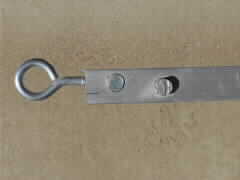
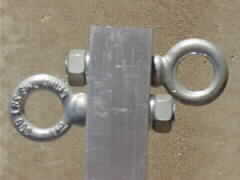
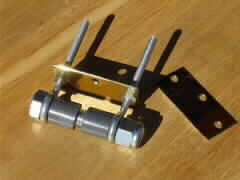
Gin Pole Bottom - Gin Pole Top - Gin Pole Mounting Hardware 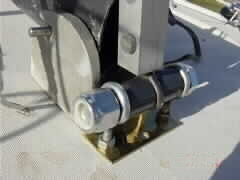
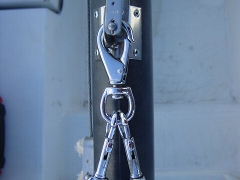
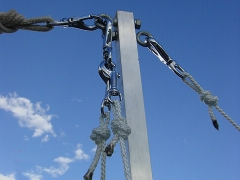
Gin Pole Mounted on Deck - Pad Eye on Mast - Gin Pole Ready 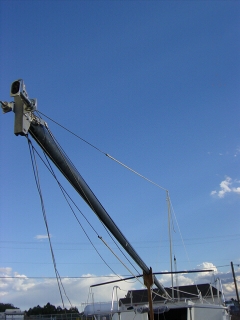
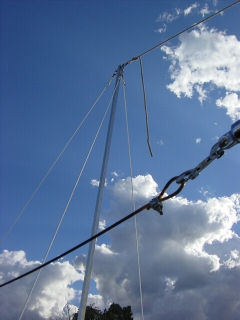
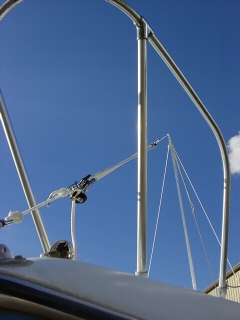
View from Stern - View from Amidships - View from Bow 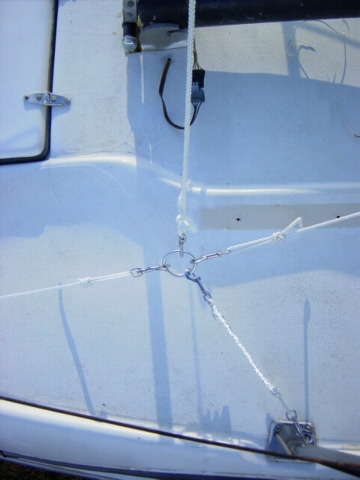
Port Side Harness 
Almost there... 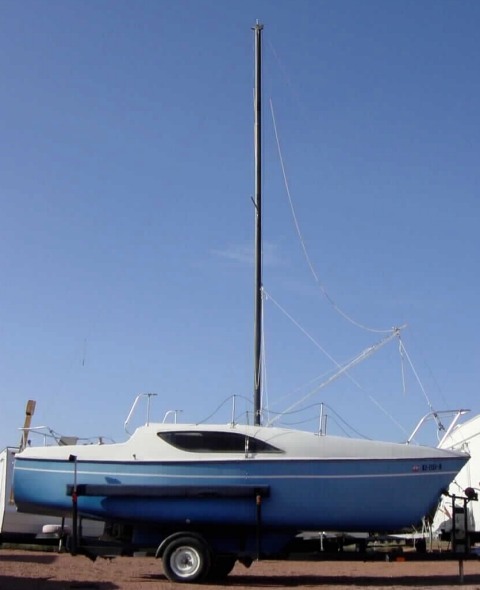
Ron Chappell is a Genius! Gin Pole Materials & Associated Hardware - $90. Invested to date: $2100 Please send all comments, tips, suggestions, warnings and threats to Mikey's Project |


